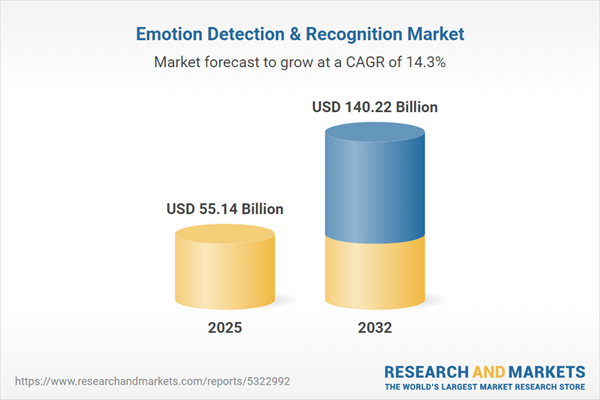Speak directly to the analyst to clarify any post sales queries you may have.
Emotion detection and recognition technology is establishing itself as a critical enabler for enterprises seeking to enhance digital engagement and operational efficiency. Senior decision-makers increasingly view these solutions as a pathway to real-time intelligence, helping both solve business challenges and strengthen relationships with stakeholders.
Market Snapshot: Emotion Detection and Recognition Market Growth
The global emotion detection and recognition market is experiencing robust expansion, driven by breakthroughs in machine learning, affective computing, and sentiment analysis. Organizations are no longer limiting their adoption to pilot phases; instead, they are integrating emotion analytics into core workflows. This integration provides immediate visibility into sentiment, enabling prompt and informed responses to both customer and employee needs. Real-time monitoring ensures that organizations can maintain a high standard of interaction across diverse channels. Companies are deploying these solutions at scale, utilizing both on-premises and cloud platforms to accommodate regulatory and operational nuances. This shift underscores the marketplace’s evolution toward digital agility and adaptive infrastructure.
Scope & Segmentation of the Emotion Detection and Recognition Market
- Component: Includes sensor devices, advanced camera units, recognition software, analytics platforms, and implementation services. These elements collectively offer end-to-end integration for organizations seeking seamless deployment within business operations.
- Technology: Encompasses facial expression analysis, voice emotion detection, physiological signal monitoring, and text sentiment analytics. Each method extends emotional intelligence across both physical and digital interaction points.
- Deployment Mode: Covers on-premises, private, public, and hybrid cloud configurations. These deployment types align with an organization’s data privacy adherence, compliance mandates, and IT complexity.
- Application: Spans automotive safety, financial sentiment evaluation, security, healthcare monitoring, retail experience, and digital marketing analytics. By leveraging sector-specific use cases, organizations can tailor their implementation to achieve strategic objectives and sector advantages.
- Organization Size: Platforms serve both large multinational enterprises and small to medium-sized businesses. This flexibility ensures that features and resource allocation can be optimized for scale and operational intensity.
- Regions: Adoption trends vary according to factors such as digital infrastructure maturity, local compliance regulations, and competitive pressures in the Americas, Europe, Middle East, Africa, and Asia-Pacific. Each region presents distinct opportunities and operational considerations for market entry and expansion.
- Key Companies: The competitive landscape includes Microsoft Corporation, Google LLC, Amazon.com, Inc., IBM Corporation, Affectiva, Realeyes, Beyond Verbal Communications, Kairos Face Recognition, iMotions ApS, and Sightcorp B.V. Strategic directions set by these organizations influence market dynamics and the pace of innovation.
Key Takeaways for Senior Decision-Makers
- Adopting emotion detection and recognition platforms enhances digital interactions, resulting in improved retention of customers and employees through more tailored experiences.
- Integrating analytics across multiple industries, including healthcare, financial services, and automotive, delivers actionable insights to refine operations and strengthen management decisions.
- Flexible deployment options are vital for maintaining regulatory compliance, safeguarding sensitive data, and supporting change as privacy requirements evolve.
- Continual investment in platform adaptability helps organizations remain robust in the face of changing regulatory standards and technical challenges.
- Ensuring interoperability between hardware, software, and IT systems accelerates adoption, reduces deployment times, and increases operational returns.
Tariff Impact: Navigating United States Policy Changes
Recent modifications to United States trade policies are prompting enterprises to revisit procurement and sourcing strategies, particularly for critical sensor and imaging technology. Many organizations are localizing supply chains, establishing assembly operations closer to primary markets, and increasing reliance on domestic sources for essential hardware. These approaches have led development teams to adapt software solutions to meet local compliance requirements and invest more in regulatory-focused teams. Collectively, these measures promote supply continuity and resilience under shifting policy conditions.
Methodology & Data Sources
The report’s findings leverage a blend of data triangulation, scenario modeling, and interviews with senior executives to ensure validity. Supplementary validation from academic literature and patent reviews enhances credibility and ensures discretion throughout the research cycle.
Why This Report Matters
- Arms leadership with information to assess emotion detection and recognition platforms based on operational effectiveness and investment impact.
- Provides benchmarks and compliance strategies for global integration, offering a practical framework as organizations expand digital operations.
- Delivers actionable perspectives to help organizations navigate supply chain adjustments and changing regulatory demands for sustained resilience.
Conclusion
Emotion detection and recognition technologies empower organizations to stay responsive, drive continuous improvement, and reinforce their competitive positioning as digital transformation accelerates worldwide.
Additional Product Information:
- Purchase of this report includes 1 year online access with quarterly updates.
- This report can be updated on request. Please contact our Customer Experience team using the Ask a Question widget on our website.
Table of Contents
3. Executive Summary
4. Market Overview
7. Cumulative Impact of Artificial Intelligence 2025
Companies Mentioned
The companies profiled in this Emotion Detection & Recognition market report include:- Microsoft Corporation
- Google LLC
- Amazon.com, Inc.
- International Business Machines Corporation
- Affectiva, Inc.
- Realeyes, Inc.
- Beyond Verbal Communications Ltd.
- Kairos Face Recognition, Inc.
- iMotions ApS
- Sightcorp B.V.
Table Information
| Report Attribute | Details |
|---|---|
| No. of Pages | 182 |
| Published | October 2025 |
| Forecast Period | 2025 - 2032 |
| Estimated Market Value ( USD | $ 55.14 Billion |
| Forecasted Market Value ( USD | $ 140.22 Billion |
| Compound Annual Growth Rate | 14.2% |
| Regions Covered | Global |
| No. of Companies Mentioned | 11 |









